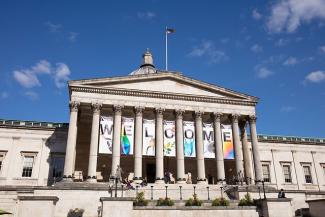
On 14 November 2024, Professor Leighton commenced his Honorary Professorship of University College London (UCL) with a lecture entitled “Are members of the public suffering adverse effects as a result of being exposed to airborne ultrasound in public places without their knowledge?“
Professor Leighton was introduced by Professor Hugh Griffiths of the Department of Electronic Engineering, the Department of UCL that chose to act as host for Professor Leighton because of his invention of the TWIPR radar system. The Department of Electronic Engineering at UCL is famed for its interest in radar, and it has probably the only university laboratory in the UK that is anchors to electromagnetic radiation.
Professor Leighton will visit UCL to help advise the researchers, particularly the PhD researchers, in their projects. He will also give additional lectures, and support other departments (such as Mechanical Engineering, which has a well-established ultrasonics group).
The abstract describing the topic of Professor Leighton’s lecture is as follows:
“This lecture covers the little-discussed topic of airborne ultrasound, and its effects on human health and well-being".
Millions of members of the public are exposed to airborne ultrasound each day in public spaces, without their knowledge. This exposure can come from entertainment and communication systems, pest deterrents, etc. If the many start-up companies that seek to exploit airborne ultrasound were to be successful, these exposures would greatly increase in coming years.
Low-intensity exposures (such as most of those that occur nowadays in public) can generate a diverse range of symptoms (headaches, dizziness, nausea, tinnitus, inability to concentrate, annoyance etc.). These are often attributed to other causes, including psychosomatic origins. High intensity ultrasound (such as some start-ups propose to use) can cause skin burning and, possibly, hearing loss (although the evidence for that has been taken using poor scientific methods).
Most of those people who are exposed today in public places receive low-intensity ultrasound, and are unaffected. This can make life particularly difficult for the minority who are affected, because their co-workers, classmates, teachers or family members in the same environment are not affected, and can doubt the authenticity of the symptoms. Those affected may not be aware of the exposure, and even if they are, the healthcare professionals they consult are influenced by the mantra that ‘humans cannot hear above 20 kHz’ (in fact, hearing thresholds at 28 kHz have been measured). Not all symptoms require the sufferers to hear the ultrasound, but some adverse responses appear to require hearing.
Proof of these public exposures, and their diverse sources, was published in 2016. Efforts since then turned an initially skeptical response into a multi-country push to re-evaluate and apply voluntary guidelines for maximum permitted exposures.
Interest in the topic briefly increased in 2018 by news reports of ultrasonic weapons being used to attack the US Embassy in Cuba, claims that lack credibility.”